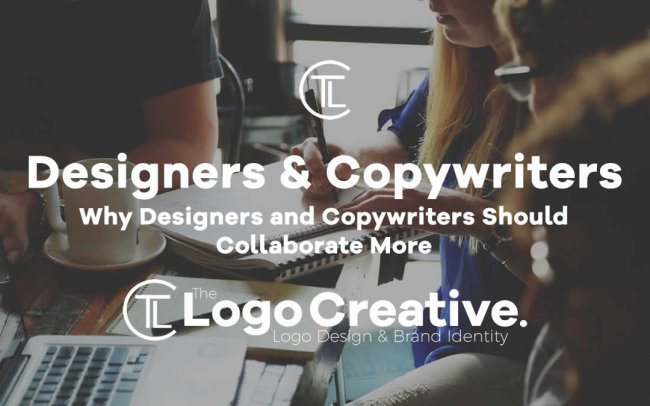“I can’t believe it. They’ve asked me to come up with brand names again.”
You could have planted potatoes in the Graphic Designer’s forehead furrows.
“I’m a Designer, not a bloody Copywriter.”
I felt his pain.
Forcing a visual person to write words is borderline workplace bullying.
Table of Contents
Words and pictures
Our two main tools of communication are words and pictures. Then, of course, there’s colour, sound, texture and possibly smell, but if you’re in design or advertising, it’s generally about the words and pictures.
As creatives, we can appreciate both, but the laws of natural selection mean that most of us lean towards one or the other.
I rarely come across a designer who is a genius writer and possibly even less so, a writer who can design their way out of a wet paper bag.
But, like apple crumble and custard, the two are better together.
Confession time
I’m one of those slightly awkward hybrid creatives, who’s spent almost as much time art directing as copywriting. However, as time has ticked by, I’ve realised that I’d have more of a fighting chance in the ring armed with a pen, than with a Pantone book.
I often look at Graphic Designers’ portfolios and think, “I wish I could do that”. Then I look at the copy and think, “I wish they’d given me a bell”.
Ideas and words are as easy for me as eating a third Hobnob, whereas design is more like juggling tadpoles. That’s why I love working with experts.
Creative teamwork
The best design agencies have Copywriters onboard, or at least bring them in on a freelance basis. What I’d like to see more of, is writers and designers spending more time with each other.
Neither discipline is a bolt-on. The headline, body copy, brand name, strapline, typeface, colour palette, composition, illustration style, photography… if they’re going to work together, shouldn’t the writer and designer too?
Now, I hate (no, that’s not too strong a word) creative brainstorming. But put two contrasting, compatible creatives together and the results can be remarkable.
It’s hard to beat that moment when a half-conceived idea meets the open and fertile mind of a creative compadre.
“I’ve had this thought, but I’m not sure what to do with it.”
“Brilliant, if we just turned it inside out and painted its toenails blue.”
“Wow, and then if we made the headline look like it was made of cheese.”
“Yeah, and get rid of that comma.”
All of a sudden an idea that was about to be pushed off a cliff onto the craggy rocks below, finds its way back to civilisation (and has a hot chocolate by the roaring log fire of a beautiful coaching inn somewhere in the Lake District).
Ridiculous analogies aside, designers and writers really should be part of the same team.
Sharing your newborn ideas may be bruising on the ego and things can get heated, but working in silos rules out many an undreamt creative possibility.
Together is better
I had a look at another copywriter’s website this afternoon. The words and ideas weren’t half bad, but the design was a dog’s dinner.
Imagine how gutting that must feel. You put all that love into your copy, then some Herbert Comic Sans’ it to death.
It’s the same for designer’s when their beautifully balanced type spells out a turgid cliché that no one wants to read.
I’m not saying that designers and writers have to live in each other’s pockets, but how about spending some time together at the start of the creative process.
Let’s get uncomfortable
If you’re used to working in your own bubble and handing almost finished work over for someone to fill in the copy gaps, it may be difficult to try something new.
You’re going to have to be open to having your thinking challenged. Your inner control freak needs to be given the day off.
If you’re up for it, here’s a toe-in-the-water approach that might help you to jump out of your comfort zone.
First, you need to let others know that you’re not available for an hour or two. No one else is invited; it’s just you and the Copywriter. Hang a DO NOT DISTURB sign on the door if that helps.
Stop thinking about the end product
Whether it’s a brochure, website or whatever, just park that for now. Worrying about the real world only gets in the way. This is a creative ‘play time’.
Write out the key points of the brief on an A3 layout pad or Nobo board. These are the messages or brand values that have to be conveyed.
For sake of argument, let’s say the core of the brief is ‘Product X puts more fun into your life’.
Now take it in turns to shout out (and write down) what ‘more fun’ means to you.
My own cinema room.
Swimming with sharks.
An infinite supply of pies.
Traveling back in time to when I was 6 years old.
The front row of an Oasis comeback gig.
A freedom pass at Disney World.
Running naked into the sea.
The ability to freeze time…
When this hits a dry patch, change to visuals.
Spend 20 minutes on laptops looking for images that ‘say’ fun. Throw them all into folders for sifting through later.
Even better, from a spontaneity point of view, get a pile of old magazines and comics and tear out anything that fits the fun brief: type, headlines, illustrations, and photographs.
Go back to your list of statements. Scrap any that don’t have the right attitude for the brand.
Throw your statements and pictures together and start sifting or creating different boards that say ‘fun’ in slightly different ways.
Once you have boards that feel coherent and bring the brand message or essence alive, the session is over.
Now what?
What’s that you say, “How’s that going to help us answer the brief?”
Well, now you have a design feel and tone of voice to aim for. What’s more, it’s something you’ve both been involved in and this makes it easier for collaborative working as the job progresses.
Maybe the writer will see a great piece of design that has something of the energy that you’re after. Perhaps you’ll come up with a headline idea or be more confident about suggesting an edit to the copy.
It’s all about creating a culture of sharing and co-operation.
Working together kicks the door of ‘So, what if…’ open a little wider, and that can only be a good thing.
 Author Bio
Author Bio
Jonathan Wilcock has worked in London advertising and design agencies as both Copywriter and Art Director. He was Creative Director on the P&O Ferries account and a Partner at Remedy Creative. He is now freelancing as a Conceptual Copywriter/Content Writer/Creative Director/Art Director (“Call me what you want, just call me”) for advertising and design agencies across London and the South East under the So, What If… brand. www.sowhatif.co.uk

